|
|
|
Sort Order |
|
|
|
Items / Page
|
|
|
|
|
|
|
| Srl | Item |
| 1 |
ID:
176262
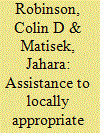

|
|
|
|
|
| Summary/Abstract |
For decades, military assistance in southern Somalia focused on building up a central state army. This reflects standard patterns of Western assistance worldwide. Yet the nature of Somali society and clan, greatly affected by the winnowing process of more than 30 years of conflict, means that most sub-clan groupings are more militarily effective than centralised forces deployed to unfamiliar areas. The centralised Somali National Army remains riven by clan itself, thoroughly politicised, and ineffective (with the exception of the Danab special forces). Based on fieldwork and interviews with military personnel who work in Somalia, Colin D Robinson and Jahara Matisek argue that these locally appropriate forces deserve assistance, albeit with some caveats, in the continuing struggle against Al-Shabaab.
|
|
|
|
|
|
|
|
|
|
|
|
|
|
|
|
| 2 |
ID:
183465
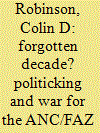

|
|
|
|
|
| Summary/Abstract |
The history of the Congo’s Armée nationale congolaise (1960–71) and Forces armées zairoïses (1971–97) between the ‘mercenaries’ mutinies’ of 1967 and the two Shaba incursions is worthy of further research. President Mobutu wished to make sure that the ANC/FAZ presented no threat to his rule, against the backdrop of scores of military coups going on across the breadth of Africa. Three key themes are evident in the history of the ANC/FAZ from 1967 to 1977, and are examined here for the first time. Mobutu controlled his armed forces mostly through divide and rule tactics, and most of the first theme discussions will focus on those affairs. The second theme is connected in a way to the first; the succession of favored praetorian guard formations. Thirdly the military linkages between the Zairian Angola incursion of 1975 and the following attempted Katangan exiles’ return to Shaba in 1977 and 1978 are sketched more strongly. A link between the second and third themes is provided by a solid background, for the first time, for the establishment of the Kamanyola Division, long an anomaly amongst Mobutu’s favored forces.
|
|
|
|
|
|
|
|
|
|
|
|
|
|
|
|
| 3 |
ID:
170277
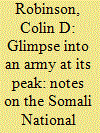

|
|
|
|
|
| Summary/Abstract |
Bagayoko, Hutchful, and Luckham correctly argue that the structures, characteristics, and operating methods of official security institutions in Africa have been somewhat neglected, with a lack of much recent research. The Somali National Army (SNA) sits among these lacunae. Its formal structures can be used as a skeletal starting point and springboard to start to draw the network diagrams that chart informal linkages. This is why recent declassification decisions by U.S. intelligence bodies, coupled with period documents released to the UK National Archives, hold significance in helping us understand early hierarchical SNA arrangements. They show the steady build-up in size of the force, to 1987, to about the time the civil war began to fragment the state.
|
|
|
|
|
|
|
|
|
|
|
|
|
|
|
|
| 4 |
ID:
178639
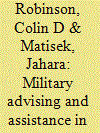

|
|
|
|
|
| Summary/Abstract |
Southern Somalia has attracted substantial military aid and assistance for decades. As the state disintegrated in the late 1980s, clan dynamics became more critical, warlords emerged, and power bases shifted. Since 2008, the number of foreign military forces and advisors (including private military contractors) has substantially increased, as has the creation of numerous Somali security units. Such actions are symptomatic of broader trends concerning multilateral attempts to rebuild security forces in fractious states, where security assistance activities lack unity or common national interests. This has resulted in various Somali military forces with different loyalties (domestic and international), capabilities, and priorities in each Federal Member State (FMS). Uneven foreign military training programs in the context of survival politics fuels the fragmentation of various security forces. Locally appropriate military forces in each FMS potentially appear to be more effective at resisting Al-Shabaab. However, locally appropriate military forces contribute to further fragmentation, as security donors bypass the Federal Government of Somalia (FGS) to directly assist these localized forces. This accelerates devolution of military forces outside of FGS control. These assessments are based on fieldwork and interviews with security officials in East Africa.
|
|
|
|
|
|
|
|
|
|
|
|
|
|
|
|
| 5 |
ID:
175432


|
|
|
|
|
| Summary/Abstract |
It appears almost certain that the African Standby Force as originally imagined will never deploy. All five regions have, however, improved military cooperation and gained significant Western investment, strengthening well-positioned elites. Virtually nothing has eventuated in North Africa, primarily because of lack of regional interest, especially following the fall of Libyan leader Mu'ammar al-Qadhafi and the ensuing civil war. Regional armies have significant problems with effectiveness; the force should only be retained if it genuinely fosters regional military cooperation.
|
|
|
|
|
|
|
|
|
|
|
|
|
|
|
|
| 6 |
ID:
189771


|
|
|
|
|
| Summary/Abstract |
On 1 July 2001, the Headquarters Joint Forces New Zealand was opened, and took command over operational deployments. This important development's origins lie generally in the movement among partner armed forces towards joint operations. But the small size of the New Zealand armed forces delayed any move towards a joint approach, which eventually had to be imposed by civilians to a much greater degree than elsewhere. The deliberations of the Derek Quigley-chaired Foreign Affairs, Defence and Trade Committee's Inquiry into Defence Beyond 2000 were crucial. Although the National-led government resisted the committee's conclusions, the ensuing Labour-led government took them up.
|
|
|
|
|
|
|
|
|
|
|
|
|
|
|
|
| 7 |
ID:
165364


|
|
|
|
|
| Summary/Abstract |
To engage properly with the Somali National Army, to understand it in the hope of improving stability and the lives of over 12 million Somalis, good basic information on its composition and characteristics is necessary. Authoritative accounts on the subject have been scarce for over 25 years. This account seeks to detail the army’s dispositions across southern Somalia, and, more importantly, the brigades’ clan compositions and linkages. Clan ties supersede loyalties to the central government. The army as it stands is a collection of former militias which suffer from ill-discipline and commit crime along with greater atrocities. Estimates of numbers are unreliable, but there might be 13,000 or more fighters in six brigades in the Mogadishu area and five beyond.
|
|
|
|
|
|
|
|
|
|
|
|
|
|
|
|
| 8 |
ID:
179031
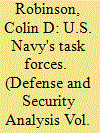

|
|
|
|
|
| Summary/Abstract |
Grouping warships for combat has evolved greatly over the centuries. In the early 1940s, the United States Navy began to group its warships for combat in much more flexible task forces than the previous single-type-of-warship formations. This system has evolved and spread to naval forces ashore but remains fundamentally unchanged. It now covers numbers between 1 to over 1000, of which the most prominent is the first 100 or so which U.S. Navy combat forces use. The numbered fleets worldwide utilize the series covering 20-79; 1-19 and 90-99 appear to be reserved for special allocations and Commander, Pacific Fleet; numbers over 80 to the Atlantic; 100-119 for Northern Europe and briefly Tenth Fleet; the 120 series for Second Fleet as a Joint Task Force leader; the 150 series for Naval Forces Central Command; and the 180 series for Atlantic Fleet and now-Fleet Forces Command.
|
|
|
|
|
|
|
|
|
|
|
|
|
|
|
|
| 9 |
ID:
161349
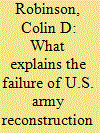

|
|
|
|
|
| Summary/Abstract |
This author wrote his doctorate thesis on post-conflict army reconstruction, submitting it in 2011. Continued research on the subject in the intervening seven years indicates that his theoretical propositions can be refined and improved. This article examines refinements to the model, and then applies those refinements in detail to the Afghan case. In so doing, it shifts the focus from potentially altruistic state-building to a case that was driven by pure national-strategic interests. Issues surrounding the liberal peace ideology dominate recent army reconstruction in conflict-affected states. The liberal peace underpinning is of supreme importance, so much so that in many discussions, it is internalised and accepted virtually without thought. This paper will advance the body of knowledge by establishing, for the first time, a theoretical basis for the widespread failure of army reconstruction in Afghanistan. The empirical basis builds on extensive previous research by other scholars. The resulting model can also be applied to better explain outcomes in other similar cases.
|
|
|
|
|
|
|
|
|
|
|
|
|
|
|
|
| 10 |
ID:
189730


|
|
|
|
|
| Summary/Abstract |
Investigations into why Western forces – primarily the US and British Armies – failed to build effective and accountable Afghan and Iraqi armies have not focused enough on the links between state and army, Colin D Robinson argues. Building strong states in such circumstances is near-impossible and has dire consequences for armies. In addition, the regular combat culture of Western armies serves them extraordinarily badly when they are called to make things, not break things, in totally dissimilar societies.
|
|
|
|
|
|
|
|
|
|
|
|
|
|
|
|
| 11 |
ID:
193528


|
|
|
|
|
| Summary/Abstract |
The collapse of Western-supported Afghan forces in mid-2021 emphasizes how difficult building whole armies can be. The Liberian experience 2004–2009 holds relevant lessons. After the civil war ended, the US State Department engaged two private military contractors to recreate a new Liberian army from the ashes. But scholarship so far on the Liberian army reconstruction process has been mixed, partially obscuring some of the core truths of the program. On reflection, the reasons for the very mixed results appear to be, first, that the idea of SSR itself is flawed, which is partially why “Security and Justice programming” is rising in prominence—local ownership in such armies is shared upwards through a multi-faceted patronage chain; second, that the Liberian state never had any meaningful history of military professionalism; and that creating an entire army was far more complicated than the usual tasks assigned to private contractors. The complete absence of any experienced leadership in the first months was devastating.
|
|
|
|
|
|
|
|
|
|
|
|
|
|
|
|
|
|
|
|
|